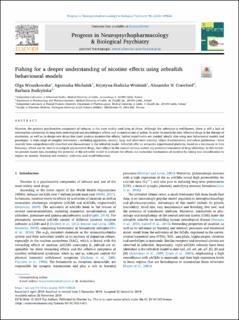| dc.contributor.author | Wronikowska, Olga | |
| dc.contributor.author | Michalak, Agnieszka | |
| dc.contributor.author | Skalicka-Woźniak, Krystyna | |
| dc.contributor.author | Crawford, Alexander Dettmar | |
| dc.contributor.author | Budzynska, Barbara | |
| dc.date.accessioned | 2020-11-11T10:52:35Z | |
| dc.date.available | 2020-11-11T10:52:35Z | |
| dc.date.created | 2020-04-26T12:40:40Z | |
| dc.date.issued | 2020 | |
| dc.identifier.citation | Progress in Neuro-psychopharmacology and Biological Psychiatry. 2020, 98, 109826, 1-10. | en_US |
| dc.identifier.issn | 0278-5846 | |
| dc.identifier.uri | https://hdl.handle.net/11250/2687342 | |
| dc.description.abstract | Nicotine, the primary psychoactive component of tobacco, is the most widely used drug of abuse. Although the substance is well-known, there is still a lack of information concerning its long-term neurological and physiological effects and its mechanisms of action. In order to search for new, effective drugs in the therapy of nicotinism, as well as to design new drugs that exert positive nicotine-like effects, further experiments are needed, ideally also using new behavioural models and paradigms. A wide range of complex behaviours – including aggression, anxiety, long- and short-term memory, object discrimination and colour preference – have recently been comprehensively classified and characterized in the zebrafish model. Zebrafish offer an attractive experimental platform, based on a microscale in vivo bioassays, which can be used to investigate psychoactive drugs, their effects on the central nervous system and potential treatments of drug addictions. In this review, we present recent data revealing the potential of the zebrafish model to evaluate the effects and molecular mechanisms of nicotine by taking into consideration its impact on anxiety, learning and memory, addiction and social behaviours. | en_US |
| dc.language.iso | eng | en_US |
| dc.rights | Attribution-NonCommercial-NoDerivatives 4.0 Internasjonal | * |
| dc.rights.uri | http://creativecommons.org/licenses/by-nc-nd/4.0/deed.no | * |
| dc.title | Fishing for a deeper understanding of nicotine effects using zebrafish behavioural models | en_US |
| dc.type | Peer reviewed | en_US |
| dc.type | Journal article | en_US |
| dc.description.version | publishedVersion | en_US |
| dc.source.pagenumber | 1-10 | en_US |
| dc.source.volume | 98 | en_US |
| dc.source.journal | Progress in Neuro-psychopharmacology and Biological Psychiatry | en_US |
| dc.identifier.doi | 10.1016/j.pnpbp.2019.109826 | |
| dc.identifier.cristin | 1808077 | |
| dc.source.articlenumber | 109826 | en_US |
| cristin.ispublished | true | |
| cristin.fulltext | original | |
| cristin.qualitycode | 1 | |

